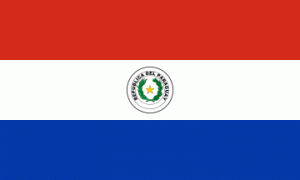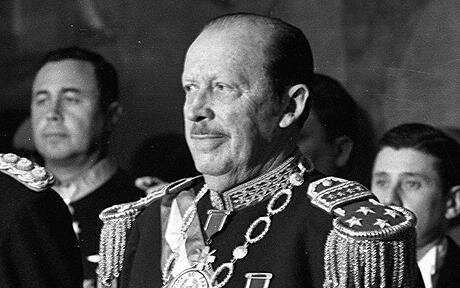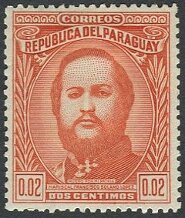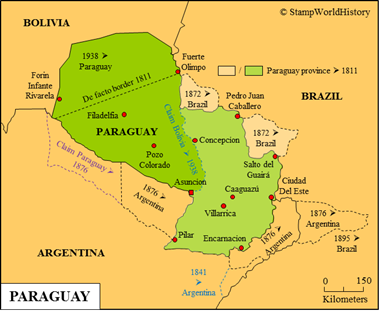
Paraguay
Quick reference
General issues: Republic 1870-Present
Country name on general issues: Paraguay
Currency: 1 Peso Fuerte = 100 3 Reales/100 Centavos 1870-1944, 1 Guarani = 100 Centimes 1944-Present
Population: 635 000 in 1900, 6 800 000 in 2013
Political history Paraguay
Colonization and independence
Paraguay is located in South America. Before colonization Paraguay was populated by a range of Amerindian peoples, the largest group being the Guarani – Amerindian peoples sharing the Guarani language. The first Europeans to explore Paraguay were the Spanish in 1516. Paraguay was colonized by the Spanish between 1537 and and 1542 and was made part of the Viceroyalty of Peru. In 1776, Paraguay became a province of the newly formed Viceroylaty of Rio de la Plata, that also included modern Argentina, Bolivia and Uruguay. When Napoleon conquered Spain, a wave of independence movements swept across the Spanish possessions in the Americas. Paraguay declared its independence as a republic in 1811.
The 19th century and the War of the Triple Alliance
Ruled by dictators, Paraguay would, after independence, know a period of political stability. This political stability allowed the country to develop, by the mid 19th century, into one of the most developed countries in South America. Expansionist ambitions – boosted by a highly developed military – made Paraguay, in 1864, engage in war with Argentina, Brazil and Uruguay. Known as the Triple Alliance War it was the largest military conflict in the history of South America. The war would last until 1870 ending in utter defeat for Paraguay. Paraguay was occupied by Argentina and Brazil from 1869 to 1876, and in peace treaties had to cede substantial parts of its territory. Estimates vary greatly, but even conservative estimates suggest that Paraguay lost over 50% of its population and the economy was uprooted.
The 20th century and the Chaco War
From the 1870’s until the mid 20th century, Paraguay has known political instability during which military dictators and authoritarian civilian presidents would gain and loose power in rapid succession. Albeit under the rule of a military dictator, political stability was finally achieved in 1954 when Alfredo Stroessner came to power. Stroessner would rule Paraguay until 1989 – the longest military dictatorship in history. His successor would pave the way for democracy. The first democratic elections were held in Paraguay in 1993. Since then Paraguay has been ruled by democratically elected presidents.
In 1932, Paraguay would once again be engaged in war – the Chaco War. Again a major conflict, ranking as the second largest military conflict in the history of South America only after the war of the Triple Alliance. Since independence, Paraguay and Bolivia have disputed the border. Supposed oil deposits caused the conflict to escalate into war – a war initiated by Bolivia. The war lasted until 1935 and ended in victory for Paraguay.
Establishing the borders

Paraguay has a history of dictators. Alfredo Stroessner was the longest ruling military dictator not only in the history of Paraguay but in the history of the world.
Upon independence in 1811, Paraguay was – following the ‘uti posseditis juris’ principle – the successor to the Paraguay province of the Viceroyalty of Rio de la Plata. The ‘uti posseditis juris’ principle implies that borders are drawn as they had been in colonial times. However, Paraguay included in its borders a substantially larger territory – territory that was disputed by Argentina and Bolivia. The borders of Paraguay, as we know them today, were established as a result of the two major wars Paraguay was involved in.
- In the aftermath of the Triple Alliance War, peace treaties were signed with Brazil and Argentina in 1872 and 1876 respectively. In these treaties the borders were established, Paraguay ceding substantial parts of its territory and reneging claims it had on Argentinian territory. In 1895, part of the territory ceded to Argentina would be transferred to Brazil.
- Since Paraguayan independence, Paraguay and Bolivia have been in dispute over the border. Several treaties had been signed, none of these would be ratified by both the Paraguayan and the Bolivian parliaments and thus, the dispute continued into the 20th century. The border as we know it today would be drawn as part of the 1938 peace treaty after the Chaco War – Paraguay gaining a large part of the territory claimed by Bolivia.
Economy and demographics
The Paraguayan economy has traditionally been, and still is, an agrarian economy – although governments in recent years have focused on diversification. Paraguay is qualified as a medium human development country on the United Nations Human Development Index , one of the three countries qualified as such in South America. The other countries rank as high or very high human development countries.
The population consists of 95% mestizo – people of mixed Amerindian and Spanish origin. The Amerindian heritage is evident from the fact that both Spanish and the Amerindian Guarani are official languages in Paraguay, both understood by over 90% of the population.
Postal history Paraguay

1947 – Issued in commemoration of Mariscal Francisco Solano Lopez, president from 1862 to 1870. Mariscal Lopez led Paraguay into the Triple Alliance War that led to utter disaster for Paraguay.
The first stamps to be used in Paraguay were the stamps of Argentina – they were used from 1868 to 1869 during the War of the Triple Alliance and can be recognized by the cancellations. The first stamps issued by Paraguay appeared in 1870 – showing the coat of arms of Paraguay, a theme that would also be used in subsequent issues. Until the 1960’s, Paraguay had a limited stamp output with themes mainly of national interest. In the 1960’s, Paraguay issued stamps increasingly aimed at the thematic collectors market – in the 1970’s and 1980’s the stamp output was almost exclusively aimed at the thematic collector. In the 1990’s, Paraguay reverted to a moderate stamp output, again with themes of national interest.
Album pages
← Previous page: Panama - Canal ZoneNext page: Peru →




